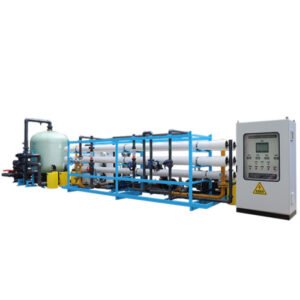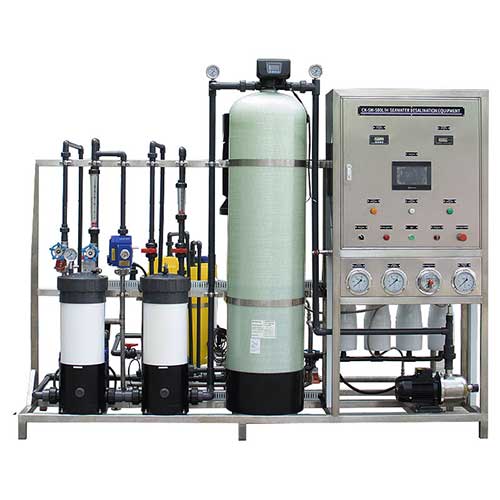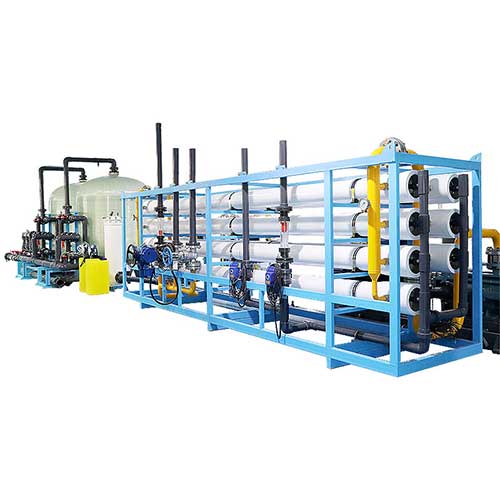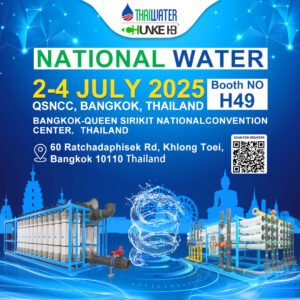Seawater Reverse Osmosis Systems SWRO
Seawater Reverse Osmosis Systems are becoming more popular. In regions where freshwater scarcity poses a significant challenge, innovative solutions are essential to meet the growing demand for clean water. CHUNKE Seawater Reverse Osmosis Systems offer a cutting-edge and reliable approach to desalinating seawater, providing a sustainable and abundant source of freshwater. With a commitment to advanced technology, efficiency, and exceptional performance, CHUNKE sets a new standard in seawater desalination.

Designed with precision and built on years of expertise, CHUNKE Seawater Reverse Osmosis Systems combine the power of reverse osmosis technology with robust engineering to tackle the complexities of desalination. These systems are address the unique characteristics of seawater, effectively removing dissolved salts, minerals, and impurities while ensuring high-quality freshwater output.
Capacity Range: 2m3 to 38m3/Day
Membrane Diameter: 2.5″-4″
Working Pressure: 700-1000psi
Feed Water TDS: 20000-40000ppm
Capacity Range: 38m3 to 2500m3/Day
Membrane Diameter: 8″
Working Pressure: 1200psi
Feed Water TDS: 20000 to 40000ppm
CHUNKE Seawater Reverse Osmosis Systems offer a comprehensive solution, incorporating critical components such as intake systems, high-pressure pumps, membranes, and sophisticated controls. These systems are designing to handle the challenges associated with seawater desalination, including fouling, scaling, and varying water conditions, guaranteeing reliable and consistent freshwater production.
Containerized Seawater Reverse Osmosis Systems
A containerized seawater reverse osmosis (SWRO) system refers to a complete seawater desalination plant that is housing within a standardized shipping container. It is a compact and self-contained unit that integrates all the necessary components of a SWRO system into a single container for easy transportation, installation, and operation, accordingly.
Hence, containerized seawater reverse osmosis systems are a practical and efficient solution for desalinating seawater, offering mobility, rapid deployment, space efficiency, simplified operation, and scalability. So, they have found applications in various sectors, including disaster relief, military operations, remote communities, and temporary water supply needs. Please see our Containerized Water Treatment Solutions.
What is a seawater reverse osmosis System SWRO?
A seawater reverse osmosis (SWRO) system is a water treatment process that uses reverse osmosis technology to desalinate seawater. And make it suitable for various applications, including drinking water supply, irrigation, and industrial processes. Meanwhile, reverse osmosis is a method of removing dissolved salts, minerals, and other impurities from water by applying pressure to force the water through a semi-permeable membrane.
In the case of SWRO, the process involves several key components:
Intake:
Seawater is taken from the ocean or sea and passed through screens to remove larger debris, such as seaweed or fish.
Pretreatment:
The seawater is then subjected to pretreatment to remove suspended solids, particulate matter, and larger contaminants. So, it could potentially damage or clog the reverse osmosis membrane. This step often includes processes like sedimentation, filtration, and disinfection.
High-pressure pump:
The pretreated seawater is pressurized using a high-pressure pump. So, the increased pressure is necessary to overcome the osmotic pressure and force the seawater through the reverse osmosis membrane.
Reverse osmosis membrane:
The heart of the SWRO system is the reverse osmosis membrane. Hence, this membrane allows the passage of water molecules while rejecting the majority of dissolved salts, minerals, and other impurities present in seawater. As a result, freshwater is separated from the concentrated brine.
Post-treatment:
The freshwater produced from the reverse osmosis process goes through post-treatment to adjust its pH, remineralize it, and disinfect it if needed. So, this ensures that the water meets the desired quality standards and is safe for consumption or other specific applications.
Disposal of concentrate:
The concentrated brine, which contains the removed salts and impurities, is typically discharged back into the ocean or a suitable water body with proper dilution to minimize its impact on the marine environment.
Seawater reverse osmosis systems are widely used in coastal regions or areas where access to freshwater is limited. But seawater resources are abundant. They offer an effective and efficient means of desalinating seawater to produce freshwater for various purposes, accordingly.
Does reverse osmosis remove salt from seawater?
Yes, semi-permeable membranes are responsible to handle this objection and very effectively removes dissolved salts. Reverse osmosis systems work by applying pressure. As it is freshwater streams through its membranes to filter out the concentrated saline in the feed water. As well as minerals and pollutants. So, these unwanted impurities are either flushing away, recycling, or processing. Sea Water Reverse Osmosis Systems are most effective way to remove salt content from salty water, accordingly.
What are the advantages of seawater reverse osmosis system?
Seawater reverse osmosis (SWRO) systems offer several advantages. These advantages are making them an attractive solution for freshwater production in regions with limited access to traditional water sources. Here are some key advantages of seawater reverse osmosis systems:
1. Abundant and Sustainable Water Source:
Seawater is an almost limitless resource, covering about 97% of the Earth’s water. By utilizing seawater, SWRO systems provide a sustainable and reliable source of freshwater, independent of freshwater supplies that may be limited or subject to drought, accordingly.
2. High Water Quality:
SWRO systems effectively remove dissolved salts, minerals, and impurities from seawater, producing high-quality freshwater. The reverse osmosis process can remove up to 99% of the dissolved solids, resulting in water that meets stringent drinking water standards or specific application requirements.
3. Versatility and Scalability:
SWRO systems are adaptable and can be scaled to meet varying demands, from small-scale residential applications to large-scale industrial or municipal projects. This versatility makes them suitable for a wide range of applications. For example, drinking water supply, irrigation, agriculture, and industrial processes.
4. Energy Efficiency:
While desalination processes require energy input, modern SWRO systems have made significant advancements in energy efficiency. Integrated energy recovery devices, such as pressure exchangers or turbines. So, it can help reduce energy consumption by utilizing the energy contained in the high-pressure brine to drive the process. So, this improves the overall efficiency of the system, making SWRO more economically viable and environmentally sustainable.
5. Water Independence:
SWRO systems provide an opportunity for regions with limited freshwater resources to become self-sufficient in water supply. By utilizing seawater, these systems reduce dependency on external water sources, mitigating the risk of water shortages and ensuring water security, accordingly.
6. Diverse Applications:
The freshwater produced by SWRO systems can be used for various purposes, including drinking water supply, agriculture, industry, and even for replenishing groundwater aquifers. So, this versatility allows for the diversification of water use and promotes sustainable development across different sectors.
7. Environmental Benefits:
Compared to alternative methods of obtaining freshwater, such as damming rivers or drilling deeper wells, SWRO systems have a lower environmental impact. They minimize the need for large-scale infrastructure projects and can be implemented in coastal areas, reducing the ecological disruption associated with altering natural freshwater sources, accordingly.
8. Economic Viability:
As technology advancements continue to improve efficiency and reduce operational costs. So, SWRO systems are becoming increasingly cost-effective. Hence, this makes desalinated seawater a viable and competitive option for meeting water demands, particularly in areas where alternative freshwater sources are limited or costly to develop.
Seawater reverse osmosis systems offer a combination of environmental sustainability, water independence, and the ability to provide high-quality freshwater. It is making them a valuable solution for addressing water scarcity challenges and ensuring a reliable water supply for communities, industries, and agriculture, accordingly.
What is the meaning of Reverse Osmosis Desalination?
Reverse osmosis desalination refers to the process of using reverse osmosis technology to remove salts and impurities from sea water or brackish water, making it suitable for various freshwater applications. So, it is a widely employed method for desalinating seawater or brackish water to produce clean, potable water.
By subjecting saline water to high pressure and passing it through the RO membrane, the desalination process separates freshwater from the concentrated brine solution. So, the freshwater, which has been effectively purified, can be collected and used for various purposes, such as drinking water supply, irrigation, or industrial processes.
Reverse osmosis desalination offers an efficient and effective means of obtaining freshwater from saline sources. So, it is providing a sustainable solution for areas facing water scarcity or relying on seawater as their primary water source.
CHUNKE seawater reverse osmosis systems
Recognizing the importance of sustainability, CHUNKE places emphasis on energy efficiency, utilizing advanced energy recovery devices and optimization strategies to minimize power consumption. By maximizing the conversion of seawater to freshwater while reducing energy requirements, CHUNKE Seawater Reverse Osmosis Systems contribute to environmental preservation and economic viability.
With a commitment to customer satisfaction, CHUNKE offers customizable solutions tailored to specific water demands, whether for small-scale residential applications or large-scale industrial projects. So, the systems are engineered with robust construction, ensuring durability and longevity, even in harsh marine environments.
CHUNKE Seawater Reverse Osmosis Systems have gained recognition and trust worldwide, serving communities, industries, and municipalities with a reliable and sustainable freshwater source. By harnessing the vast potential of seawater and employing advanced technology, CHUNKE is at the forefront of the global effort to overcome water scarcity challenges and provide clean water for a better future, accordingly.



